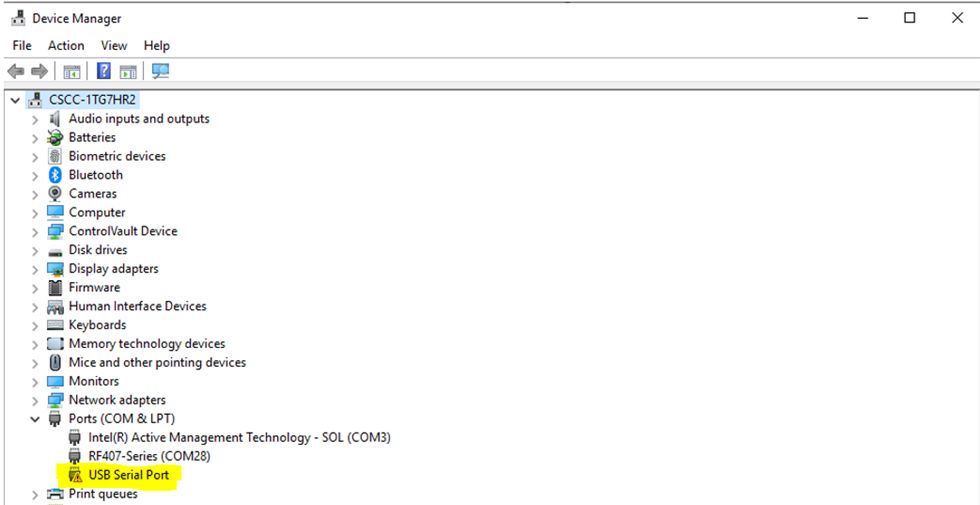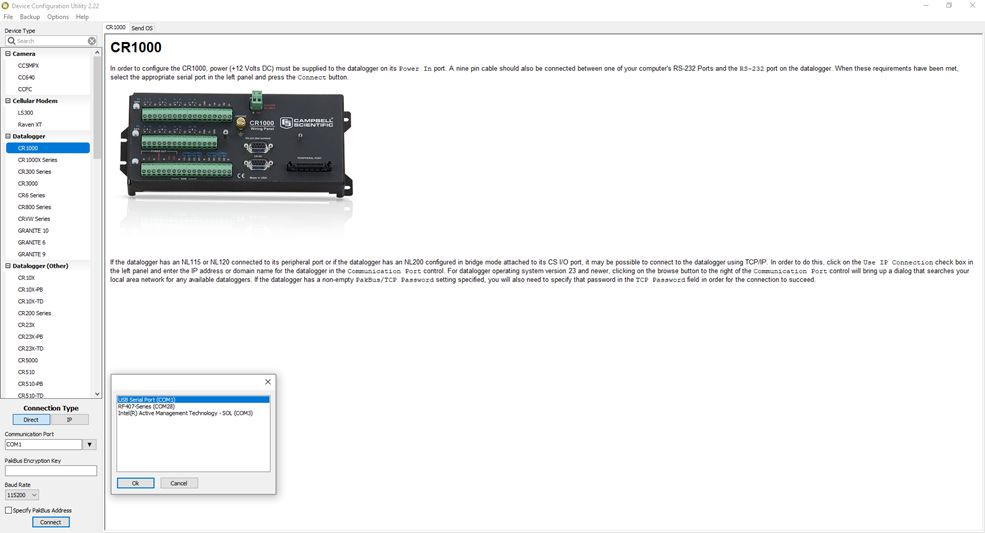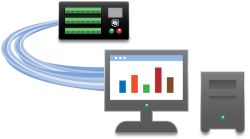Este producto ya no está disponible y ha sido reemplazado por: CR350. Algunos accesorios, recambios o servicios pueden todavía estar disponibles.

| Services Available |
|---|
Resumen
El CR800 es un datalogger con pocos canales, de grado científico y diseñado para funcionar de forma desatendida en condiciones remotas y duras. Es ideal para configuraciones con pocos sensores. El CR800 realiza las medidas de los sensores, y transmite los datos mediante los periféricos de comunicaciones; son compatibles la mayoría de sensores y periféricos de comunicaciones. Puede funcionar autónomamente o formar parte de una red de dataloggers.
El modelo CR850, es igual al CR800, pero incorpora un teclado/display.
Leer másVentajas y características
- Es ideal en aplicaciones relacionadas con perfil viento, estaciones meteorológicas, ETo/agricultura, calidad del aire, humedad suelo, nivel agua, acuacultura, ensayos automoción, TDR (Time Domain Reflectometry), SCADA, y calidad de aguas
- El CR800 y CR850 tienen un diseño simple. Son fáciles de programar y cablear
- Admite comunicaciones serie RS232 con sensores inteligentes y dispositivos compatibles, a través de los puertos COM del datalogger (puertos de control a pares)
- Contiene un chip ASIC que expande la capacidad de contaje de pulsos, puertos de control y comunicaciones serie
- Compatible con periféricos de ampliación de canales, permitiendo expandir el sistema de adquisición
- Soporta protocolos PakBus, Modbus, SDI-12 y DNP3
- Incluye puertos CS I/O y RS-232 para conectar dispositivos de comunicación
- Entradas protegidas por tubos de descarga de gas (GDT)
- Reloj salvaguardado por pila interna, lo cual permite tener en hora el datalogger aunque no haya alimentación externa
- Programable con LoggerNet, PC400, o Short Cut
Imágenes











Ficheros CAD:
Descripción detallada
El CR800 lo forma toda una electrónica encapsulada dentro de una carcasa de plástico y el panel de conexiones. Este datalogger se alimenta externamente y admite teclado/display externo. Su bajo consumo hace que funcione por largos períodos de tiempo aún utilizando una batería recargable con placa solar — sin necesidad de disponer de 220Vac. Cuando la alimentación está por debajo de 9.6 V, se detiene, reduciendo la posibilidad de realizar medidas incorrectas.
El sistema operativo incluye instrucciones para programar el datalogger: de medida, de procesado de datos y de almacenamiento (output). El lenguaje de programación, denominado CRBasic, usa una sintaxis similar al BASIC. Incluye instrucciones de medida para puentes de medida, voltaje, termopares y pulsos/frecuencia. Las instrucciones de procesado incluyen operaciones algebraicas y estadísticas. Las instrucciones de salida procesan los datos a intervalos de tiempo programables y permiten controlar dispositivos externos.
Especificaciones
| -NOTE- | Note: Additional specifications are listed in the CR800-Series Specifications Sheet. |
| Operating Temperature Range |
|
| Maximum Scan Rate | 100 Hz |
| Analog Inputs | 6 single-ended or 3 differential (individually configured) |
| Pulse Counters | 2 |
| Voltage Excitation Terminals | 2 (VX1, VX2) |
| Communications Ports |
|
| Switched 12 Volt | 1 terminal |
| Digital I/O |
|
| Input Limits | ±5 V |
| Analog Voltage Accuracy | ±(0.06% of reading + offset) at 0° to 40°C |
| ADC | 13-bit |
| Power Requirements | 9.6 to 16 Vdc |
| Real-Time Clock Accuracy | ±3 min. per year (Correction via GPS optional.) |
| Internet Protocols | FTP, HTTP, XML POP3, SMTP, Telnet, NTCIP, NTP |
| Communication Protocols | PakBus, Modbus, DNP3, SDI-12, SDM |
| Idle Current Drain, Average | 0.7 mA (@ 12 Vdc) |
| Active Current Drain, Average |
|
| Dimensions | 24.1 x 10.4 x 5.1 cm (9.5 x 4.1 x 2 in.) |
| Weight | 0.7 kg (1.5 lb) |
Compatibilidad
Nota: lo siguiente muestra información de compatibilidad notable. No es una lista de todos los productos compatibles.
Software
| Producto | Compatible | Nota |
|---|---|---|
| LoggerNet | (Version 3.3 or higher) | |
| PC200 (retired) | ||
| PC400 | (Version 1.4 or higher) | |
| RTDAQ | ||
| Short Cut |
Miscelaneo
| Producto | Compatible | Nota |
|---|---|---|
| VISUALWEATHER | (Version 2 or higher) |
Información de compatibilidad adicional
Sensores
El CR800 dispone de diversos tipos de canales, y es compatible con casi todos los sensores existentes, incluyendo termopares, sensores SDI-12, o señales 4-20mA. Su especial chip ASIC, expande las posibilidades de los puertos de control I/O en canales contadores adicionales, comunicaciones serie RS232 y SDI-12.
Periféricos de medida y control
El CR800 es compatible con todos nuestros módulos SDM, CDM (con SC-CPI), multiplexores, interface de cuerda vibrante, TIMs y relés.
Comunicaciones
El CR800 puede comunicar con un PC por conexión directa RS232, interface EtherNet NL201, Wi-Fi NL240, modems multidrop (RS485), modems telefónicos (línea terrestre u línea móvil), radio y satélite (Argos, GOES, Meteosat, Iridium).
Los datos pueden visualizarse in-situ, mediante los teclado/display CR1000KD, CD100, CD295, móvil/tableta con iOS o Android (con software LoggerLink), PDA (con software PConnect o PConnectCE).
El modulo SC115 es el único dispositivo de almacenamiento externo compatible. Al no disponer de puerto para periféricos, no es compatible con los módulos CFM100, NL116, o NL121.
Armarios intemperie
El CR800 junto con una fuente de alimentación se ensamblan habitualmente dentro de uno de nuestros armarios.
Alimentación
Cualquier fuente de 12Vdc puede alimentar el datalogger CR800. Habitualmente se usan nuestras fuentes BPALK, PS150 y PS200. La BPALK incluye ocho pilas alcalinas no-recargables que proporciona 7.5Ahr a 20°C.
Tanto la PS150 como la PS200 incluyen una batería recargable de 12Vdc 7Ahr y regulador de carga. La fuente de carga puede ser tanto una placa solar como un transformador a 220Vac. Estas dos fuentes difieren en el regulador de carga. La PS150 tiene un regulador de carga estándar, mientras que la PS200 lleva un regulador de carga inteligente basado en micro-controlador. El regulador de la PS200 es de voltaje constante de dos pasos con compensación de temperatura que optimiza la carga de la batería e incrementa su vida útil.
También tenemos disponibles las baterías de 12Vdc modelos BP12 y BP24, que proporcionan 12Ah y 24Ah respectivamente. Estas baterías deben conectarse a un regulador (como nuestros CH100 o CH200) y a su vez a una placa solar o transformador a 220Vac.
Software
El CR800 se programa con el lenguaje CRBasic, el cual permite integración de datos y cálculos.
Documentos
Folletos producto
Documentos técnicos
- Benefits of Input Reversal and Excitation Reversal for Voltage Measurements
- Data Streaming
- Preventing and Attacking Measurement Noise Problems
- Voltage Accuracy, Self-Calibration, and Ratiometric Measurements
- BACnet to Modbus Protocol Conversion (App. Note: 1M-C)
- DNP3 with Campbell Scientific Dataloggers
- Serial Sensors: Interfacing with CSI Dataloggers (App. Note Code: 2MI-V)
- FTP Troubleshooting
Conformidad
Videos & Tutoriales
Descargas
CR800 OS v.32.05 (4.38 MB) 06-01-2020
Execution of this download installs the CR800 Operating System and Compiler on your computer. It also updates the CR800 support files for the CRBasic Editor.
Note: This OS has crossed the 2 Meg CR800 size limit for remote download. The OS must be downloaded to the 2 Meg CR800 via direct connect with the Device Configuration Utility. All OS download methods are supported by the 4 Meg CR800.
Upgrading from versions prior to version 28 of the Operating System will reset the datalogger’s CPU drive. This is due to a change in the format of the file system from FAT16 to FAT32. In order for the datalogger to operate correctly, as part of the upgrade, the CPU drive is formatted to FAT32. Any programs stored and running from the CPU drive will be lost. It is not recommended to update the datalogger’s Operating System over a remote connection where program control regulates the communication equipment (turning it on or off, etc.). In these cases, an on-site visit and a backup using DevConfig’s backup utility is necessary to update the datalogger’s Operating System.
Watch the Video Tutorial: Sending an OS to a Local Datalogger.
In all cases where the datalogger is being updated from an Operating System prior to 28, the use of DevConfig’s backup utility is recommended due to the CPU drive being formatted using the new FAT32 format.
Device Configuration Utility v.2.29 (54 MB) 15-11-2023
A software utility used to download operating systems and set up Campbell Scientific hardware. Also will update PakBus Graph and the Network Planner if they have been installed previously by another Campbell Scientific software package.
Supported Operating Systems:
Windows 11 or 10 (Both 32 and 64 bit)
Preguntas frecuentes
Número de FAQs relacionadas con CR800: 158
Expandir todoDesplegar todo
-
The potential transformer and the current transformer provide differential outputs that have galvanic isolation from the voltage and current in the circuit they are measuring. However, there is no need to run the outputs of these transformers into differential inputs of the data logger and unnecessarily consume additional data logger channels. We conducted extensive testing for noise immunity, for inaccuracies from ground loops, and more before concluding that single-ended measurements in the ACPower() instruction have the same performance as differential measurements would provide. Please note that as a result of the galvanic isolation of the potential transformer and current transformer, the data logger ground is NOT connected to the ground of the circuit they are measuring.
Said differently, you can connect differential outputs of a sensor to single-ended inputs of the data logger. However, doing so creates the possibility of poor common-mode noise rejection in the data logger and the possibility of introducing inaccuracies from ground loops between the sensor and the data logger. Note that in this application, the transformer isolation of the potential transformer and the current transformer eliminates these concerns.
Simply connect one of the potential transformer secondary wires and one of the current transformer secondary wires to the data logger ground. Which wire in either case makes a difference, as the phase information allows the measurement of power flowing in either direction. If you measure negative real power when it should be positive, then reverse the secondary wires of the potential transformer where they connect to the data logger. Alternatively, you can reverse the secondary wires on the current transformer, but don't reverse both pairs of wires.
-
1. Connectez l'alimentation électrique au système d’acquisition de données
- Assurez-vous que le câble est branché dans “Power In”
- Pour tester la puissance dans un système d’acquisition qui n'a pas d'ecran, utilisez un multimètre pour tester. (Si l'alimentation est en cours, vous devriez lire environ 12 Volts)
2. Télécharger le pilote
- Si vous avez acquis le système d’acquisition de données de chez Campbell Scientific, un CD a été fourni avec le logiciel du pilote.
- Si vous n'avez pas le CD, Vous pouvez télécharger la dernière version du pilote a www.campbellsci.ca/l17394.
- Si vous avez acquis le système d’acquisition de données d'un autre fabricant, Vous devez télécharger la dernière version du pilote de leur site Web.
3. Ouvrez le Gestionnaire de périphériques
- Dans le menu Démarrer de Windows, accédez -> “Device Manager” -> “Ports”
- Si le programme “Device Manager” est bloquée, vous avez besoin d’obtenir les autorisations nécessaires de l'administrateur informatique.
- Si l’icône ci-dessous apparaît, cela signifie que le pilote n’été pas installée correctement et doit être réinstallé.
 4. Tester le cable
4. Tester le cable- Pour s'assurer que le câble fonctionne correctement, connectez l'extrémité de ce câble dans un port USB de votre ordinateur.
- Si “USB Serial Port” apparaît sous l’onglet “Ports” mentionné ci-dessus, le câble fonctionne correctement.
5. Connecter avec un système d’acquisition de données- Dans le menu démarrer de Windows, accédez -> “Device Configurator” -> “Utility”-> Dataloggers -> Select your Device
- Connection type -> Direct
- Communication port -> USB serial port -> ok -> Connect.
 6. Impossible de se connecter avec un système d’acquisition de données
6. Impossible de se connecter avec un système d’acquisition de données- Garder le programme “Device Configurator” ouvert-> retiré le cordon électrique -> cliquer sur “Connect” -> connectez le câble d'alimentation.
Si vous ne parvenez pas à vous connecter au système d’acquisition de données, n'hésitez pas à contacter notre équipe de support technique expérimentées par courriel à support@campbellsci.ca, ou par telephone à (780) 454-2505. -
Yes, unless the CR1000 program contains measurement instructions for channels not available on the CR800 or CR850.
-
Yes, but it is difficult and time consuming. The display is best used to make small changes in an existing program already installed in the data logger.
-
No, unless the internal lithium battery is below 2.7 Vdc. The lithium battery helps preserve the data, program, and clock setting when the 12 Vdc battery is removed.
-
Yes. Refer to the SerialIn() and SerialOut() instructions in the CRBasic Editor.
-
Calibration is recommended every two years.
-
Use the CURS100 device or a precision 100 ohm resistor to make 4 to 20 mA measurements.
-
No. The CR800 and CR850 do not have the necessary peripheral port to connect to an NL115.
Casos de aplicación
Background In 2022, ECR Medio Ambiente assumed the responsibility of overseeing the structural monitoring installation at......leer más
International partnerships for sustainable innovations Improved water use in agriculture is essential to successfully adapt to......leer más
Southwestern South Africa had three consecutive dry winters—from 2015 through 2017—resulting in the Cape Town......leer más
Summary Problem The University of Birmingham had set up and was operating 26 weather stations across the......leer más
In August 2012, RESPEC was contracted to provide field instrumentation and early-warning monitoring services at......leer más
The Silkwood sugarcane water-quality monitoring site was established in 2014 as part of the Paddock......leer más
The Silkwood sugarcane water-quality monitoring site was established in 2014 as part of the Paddock......leer más
In February of 2015, Campbell Scientific was awarded a bid to supply the Harris County......leer más
Artículos y notas de prensa
Artículos boletín
- Case Study: Rain Forest Turbidity in Panama 28-10-2016
- Case Study: Hydro-SCADA System in Northern California 18-04-2016
- Case Study: Houston Transitions to ALERT2 18-04-2016
- Case Study: Geothermal Development in Colombia 02-02-2016
- Powerful New Operating System for CR800, CR1000, CR3000 04-02-2015
- New Operating System for CR800, CR1000, CR3000 17-08-2012







































































